How the right to guns was written into the US Constitution
The situation when the right to bear arms is written into the Constitution is rather rare and unusual. Historians have been able to count only 15 such constitutions ever existed in nine countries. To date, only three of them are operating, including the American one.
American colonists brought confidence in their unconditional right to weapons from the European continent. By the 17th century in England, as in many other European countries, the possession of weapons was widespread among people of almost all classes. Any attempts by the state to limit this right were met with hostility and quickly cancelled. Adopted in 1689, the Bill of Rights finally secured for the British, regardless of class and financial situation, the right to own weapons.
American colonists brought with them from the European continent confidence in their unconditional right to weapons.
In the newly formed United States of America, citizens' confidence in the right to bear arms has become even more pronounced. Freed from the tyranny of Great Britain, they were sensitive to any encroachment on personal freedoms. Also, in 1787, when the US Constitution was written, the country was predominantly rural, insecure, and citizens needed guns to defend themselves.
For the Founding Fathers of the United States, gun ownership was also a matter of the independence and true freedom of their country. After the Revolutionary War, they were justifiably distrustful of the regular army, believing that it could be a potential threat to freedom. In their view, all citizens were to be "part-time soldiers". This would make it possible to mobilize against the regular army, for example, if its commanders suddenly decide to seize power and attack dissenters, argued one of the founding fathers, Alexander Hamilton. He was sure that only armed citizens would be able in this case to repulse the army and defend democracy. It was for these reasons that the Second Amendment, guaranteeing US citizens the right to keep and bear arms, entered the 1791 Constitution. In addition, many states would simply refuse to ratify the Constitution without first obtaining guarantees against the arbitrariness of the central government. Without them, the state simply could not unite. So the Founding Fathers passed the Second Amendment almost unanimously.
However, the wording of the Second Amendment leaves a lot of room for interpretation. Her text consists of 27 words and sounds like this :
A well regulated Militia, being necessary to the security of a free State, the right of the people to keep and bear Arms, shall not be infringed be violated).
The interpretation of this wording has become a stumbling block in discussions about the right to arms. Whether it refers to individual or collective right has not yet been decided. Supporters of gun control are convinced that the authors of the Second Amendment did not have in mind the carrying of weapons for "personal" needs, but they were talking specifically about the militia. While their opponents, on the contrary, believe that the Second Amendment guarantees an individual right to weapons, not tied to service in the militia.
Early Discussions on the Second Amendment: Collective or Individual Right?
Disputes about the interpretation of the Second Amendment began already at the beginning of the 19th century. The first precedent was Bliss v. Commonwealth , heard by the Kentucky Supreme Court in 1822. The case concerned the state's 1813 ban on concealed weapons. The court regarded the Second Amendment as "a categorical right to carry personal weapons in any way the owner deems appropriate, whether hidden or open" and struck down the ban as unconstitutional. In this case, the court unambiguously interpreted the right to weapons as an individual one.
The courts of some other states have interpreted it differently. So, in 1840, the Tennessee Supreme Court considered that the Second Amendment speaks of the general protection of the people as a whole, and upheld the ban on the carrying and circulation of weapons that pose a threat to society and are not typical of military operations. Similarly, State v. Buzzard (1842) upheld the concealed carry ban: here, too, the court interpreted the Second Amendment as a collective right. However, Nunn v. State (Georgia, 1846) held that "the right of all persons, old and young, men, women and children, and not only members of the militia, to keep and bear any weapon, and not only that used by the militia, may not be infringed or curtailed (…) and any law, federal or state, is contrary to the Constitution and may be held invalid if it is contrary to this right.
Even despite the numerous assassinations of US presidents with gunshots – Lincoln in 1865, Garfield in 1881, McKinley in 1901 – legislative restrictions at the federal level did not follow until the middle of the 20th century.
In the first half of the 19th century, the difference between the United States and other countries in the field of carrying weapons was not so big: in European countries this right was not guaranteed by the Constitution, but in fact it was not too limited. But the further, the more other countries followed the path of restrictions – and in the United States, politicians referred to the fact that their hands were tied by the Constitution. Yet the Constitution was more of a pretext than a real reason. First, because in the United States there is an example of a repealed constitutional amendment – this is the famous Eighteenth Amendment, which introduced "prohibition", which was adopted in 1917 and repealed in 1933. Secondly, without repealing the amendment, it is easy to limit the gun permit in such a way as to exclude mass shooters. For example, at the time of the adoption of the Second Amendment (in 1791), not only automatic and semi-automatic weapons did not exist, but even the mass production of revolvers, a pistol of that time could fire at best two shots per minute – not the most suitable weapon for mass murder . But even the type of weapons allowed to be carried by politicians is in no hurry to limit, so the reasons here are not so much legal as political.
National Firearms Act of 1934: An Attempt at Compromise
One of the most serious attempts to control the circulation of weapons was made by President Franklin D. Roosevelt. By the time he came to power in 1933, the country was covered by an unprecedented wave of crime: first because of the Prohibition, and then because of the Great Depression. Mass executions also became more frequent – for example, the famous massacre on St. Valentine's Day , when mafiosi from the Al Capone group shot seven people on February 14, 1929 in Chicago. In 1933, Roosevelt himself was nearly killed with a gunshot: 33-year-old Giuseppe Zangara shot him in Miami with a .32 caliber pistol, fatally wounding Chicago Mayor Anton Cermak.
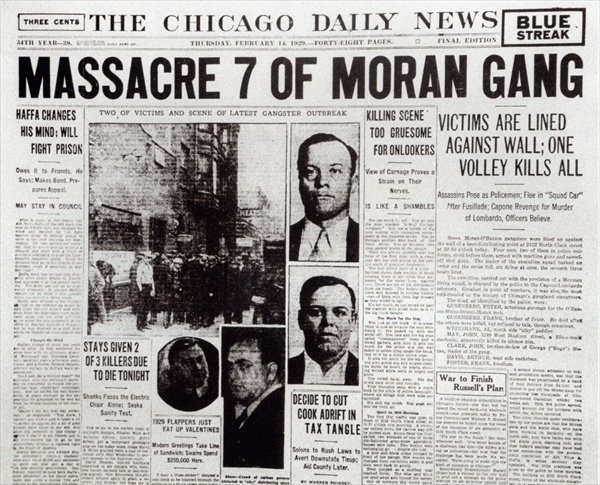
An attempt to limit the circulation of civilian weapons during this period could be associated not only with organized crime, but also with social unrest caused by the Great Depression. The March of World War I Veterans in 1932 led the authorities to seriously fear that the protesters, armed and frustrated by the non-payment of compensation, might move from marches to more decisive action.
A march by World War I veterans has led authorities to fear that armed protesters might take more decisive action.
By the 1930s, two dozen states had approved gun control laws. One of the important precedents was the Sullivan Act , adopted in the state of New York back in 1911, which restricted the carrying of concealed weapons and required their licensing. After him, other states began to introduce similar restrictions. For example, in Michigan, a police permit was required to purchase guns, while in West Virginia, a license was required.
Roosevelt wanted to change legislation at the federal level. In 1934, he passed the National Firearms Act , which mandated that purchases of "Section II" weapons, such as machine guns, short rifles, heavy weapons, and camouflaged or homemade firearms, be registered (and heavily taxed as well). Initially, the US president's plans were to oblige the registration of any firearms, as well as introduce a rule for all new buyers to be fingerprinted. However, this idea has met with strong resistance. Opponents insisted that this law would hit good citizens, leaving them defenseless against gangsters. They still appeal to this argument today.
Opponents of the National Firearms Act insisted it would leave citizens defenseless against gangsters.
One of the main opponents of the expanded version of the law was the National Rifle Association (NRA). Founded in 1871 as an ordinary sports and shooting organization, the main purpose of which was the organization of shooting competitions and shooting ranges, from the beginning of the 20th century it began to actively interfere in politics, by all means preventing the adoption of laws restricting the circulation of civilian weapons. Formally, the NRA supported a truncated version of the 1934 law, but in the same year created a Legislative Affairs Division in its structure, which in 1975 would become the Institute for Legislative Action. Pretty soon, the NRA will achieve huge political influence and will no longer just lobby for some laws and prevent others, but also fund the election campaigns of the right politicians. This organization remains the most powerful lobbyist in matters of civilian weapons today.
Gun Control Act of 1968 and expansion of NRA influence
The next major tightening of legislation occurred only 34 years later. Although the reasons for this arose much earlier. In 1949, for example, the largest mass shooting to date took place: unemployed veteran Howard Urnu killed 12 people and wounded four more in Camden, New Jersey. However, it was not until the 1960s that a series of high-profile political assassinations took place in the United States in earnest about restrictions. In 1963, President John F. Kennedy was shot dead in Dallas (the assassin Lee Harvey Oswald acquired the rifle by mail ordering from the NRA magazine catalog), and in 1968, with a difference of two months, the leader of the African American rights movement Martin Luther King and the US senator were killed Robert Kennedy.
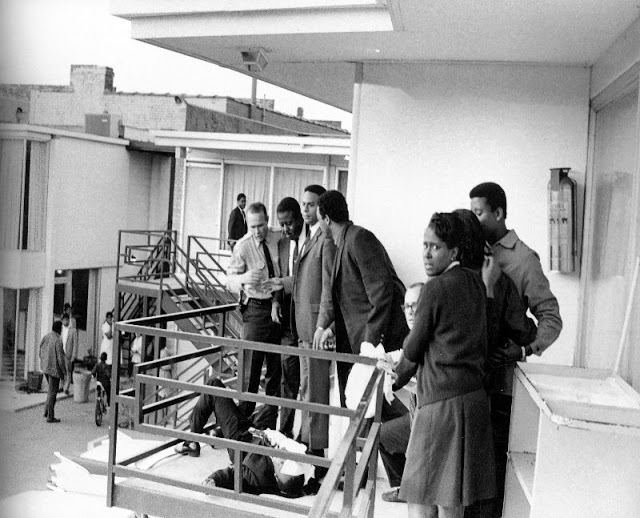
The Gun Control Act of 1968 banned the sale of guns to minors, the mentally ill, drug addicts, and persons convicted of criminal offenses for more than 1 year. In addition, he limited trade somewhat, such as banning mail-order sales and reducing imports and interstate sales. But even then, nationwide registration of weapons and their buyers was never introduced. In addition, there was no common database of buyers at that time, and therefore the accepted restrictions were not always respected.
The situation was somewhat improved by the 1993 Brady Act , which attempted to solve the problem of the lack of a nationwide database. Now, arms sellers had to wait five days, so that law enforcement agencies could verify the buyer's personal data during this time.
The next major victory was the 1994 Assault Weapons Ban , when Congress banned the sale of 150 models of semi-automatic weapons. It was a politically risky move. According to the memoirs of Republican Senator from Michigan Fred Upton, after voting for this ban, he was forced to stay under police protection for six months.
The ban was for ten years. In 2004, under George W. Bush, despite numerous public efforts, it was simply not renewed. It didn’t even help that research proved the effectiveness of the ban: during the period when it was in effect, the number of deaths from mass executions (which are most often committed using semi-automatic weapons) decreased, and since 2004, when the ban was no longer in force, there has again been a sharp increase. the number of victims.
During the period when the Assault Weapons Ban of 1994 was in effect, the number of deaths from mass shootings decreased
The ban was not extended largely due to the activities of the NRA, which has become one of the most influential lobbying groups in the United States. The organization has its own ratings of politicians and congressmen. They are ranked from A to F based on their stance on guns, where A+ is the highest support for the NRA on all significant issues, and F is consistent support for gun control. A political career often depends on these ratings: the NRA actively supports the right politicians at all levels. So, according to some estimates , the organization invested $ 30 million in the Trump presidential campaign, in addition, it supported 99 more politicians who agreed with their agenda.
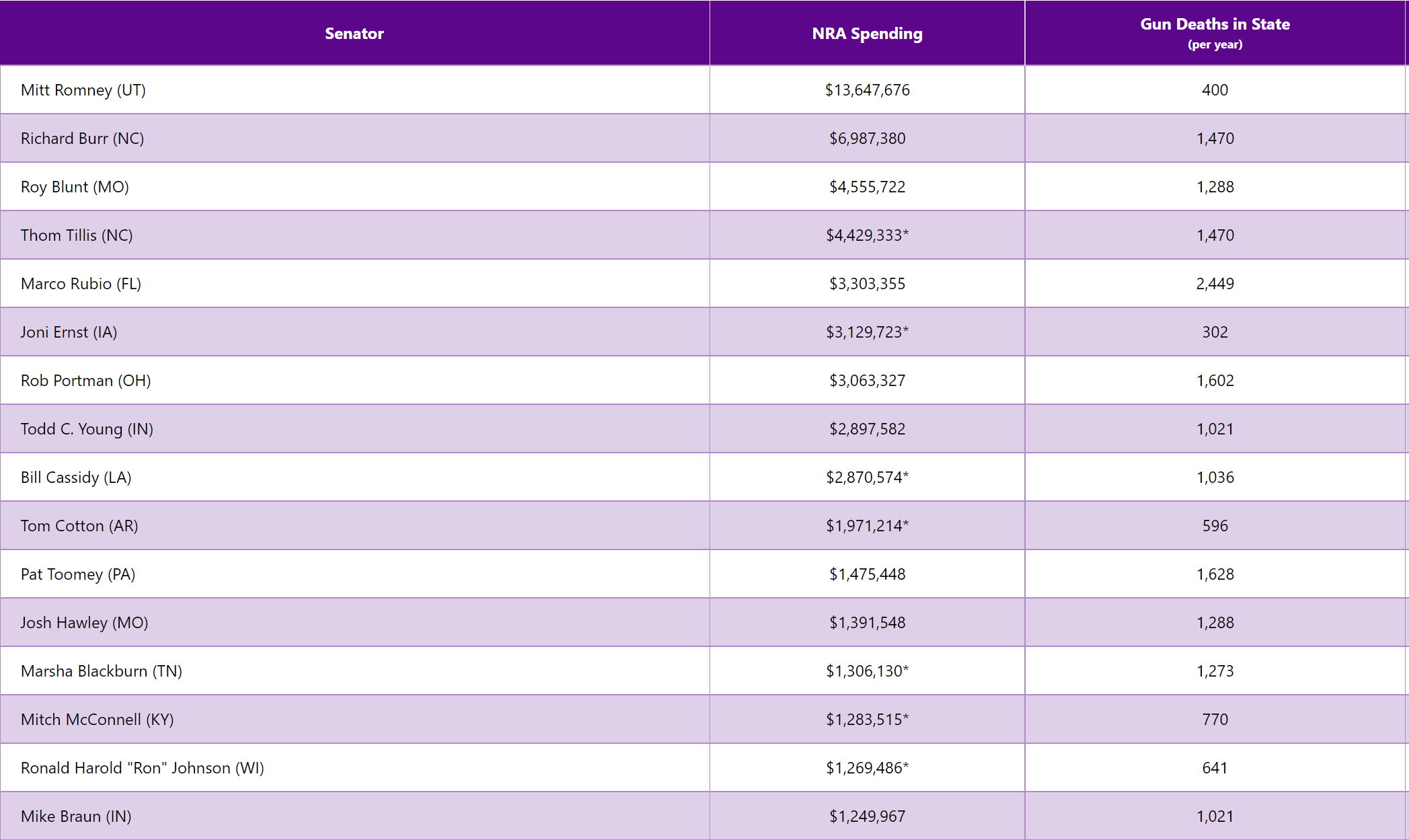
The United States is the absolute leader in weapons and mass executions
Today, the United States is the absolute leader in terms of the number of civilian weapons per capita. According to the independent Swiss research project Small Arms Survey , there are 393 million weapons per 326 million people. For 100 people – 120 civilian weapons. For comparison, Yemen, the second country in this ranking, has only 53 units. Thus, constituting only 4% of the world's population, Americans own 46% of the world's stock of civilian firearms.
Some US cities, such as Baltimore, Maryland, have more gun stores than Starbucks or McDonald's. The AR-15 semi-automatic rifle — the primary weapon of Stephen Paddock , who killed 58 and wounded more than 700 people at a Las Vegas concert, and the favorite rifle of many other mass murderers — can be bought in some states with just a driver's license. No license, no permit, no mental health certificate needed. Moreover, the AR-15 can be quite legally modified , after which it can serve almost as an automatic weapon: an improved butt allows the trigger to move much faster than in the original design.
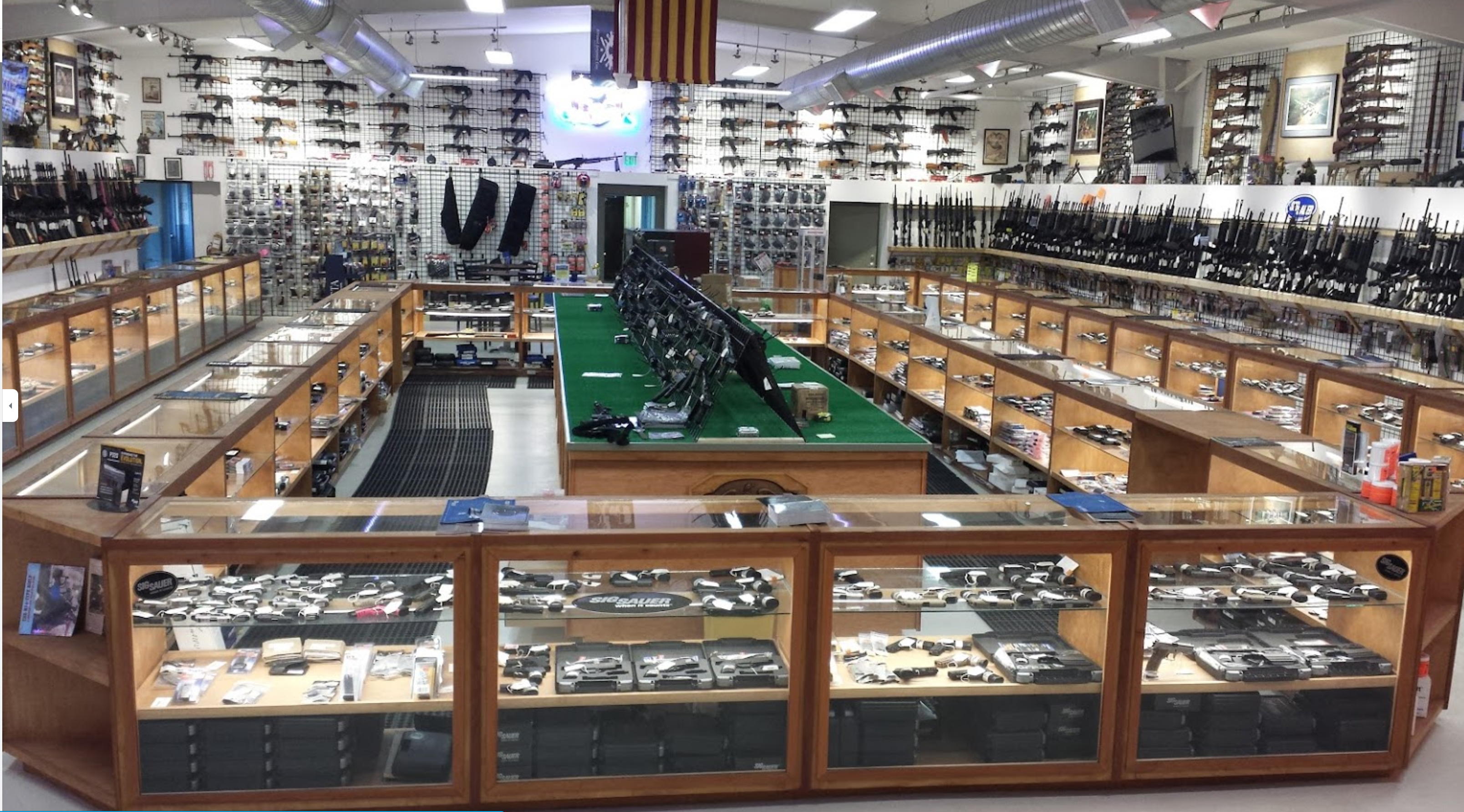
80% of homicides in the US are committed with firearms. For comparison : in the UK this figure is 4%. At the same time, the number of deaths from gunshots in the United States is growing from year to year and in 2021 exceeded 20 thousand people – this is 10 times more than all the losses of the United States during the 20 years of the war in Afghanistan. Among those killed were 313 children under the age of 11 and 1,248 teenagers aged 12 to 17. The number of mass shootings is also impressive – 692, that is, on average, almost two mass shootings per day, an absolute anti-record for all the years of observation. In states with stricter gun regulations, as you might expect, all of these figures are noticeably lower .
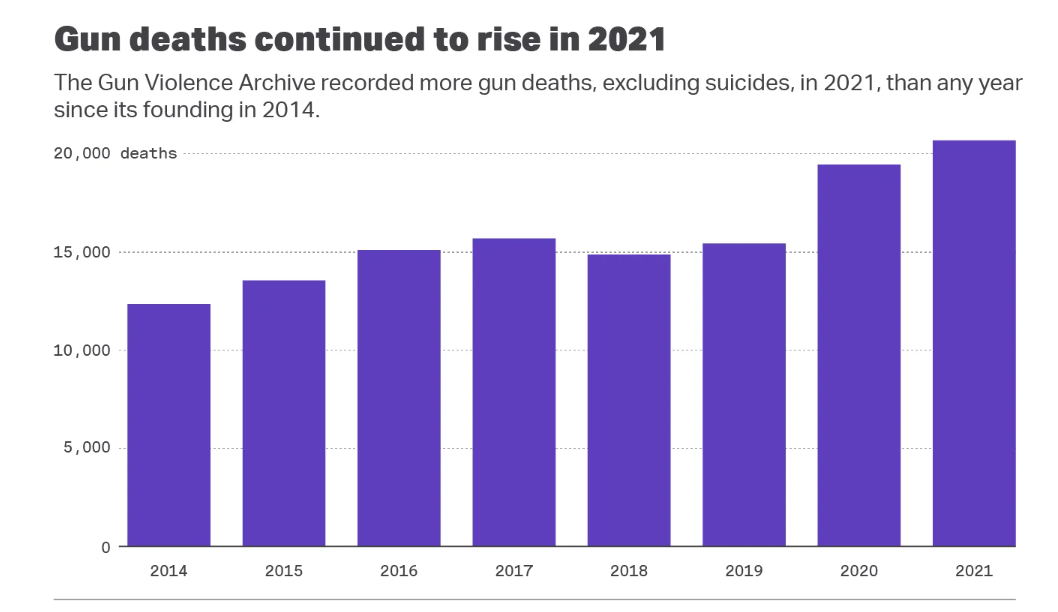
The gun advocates' main argument – "the best defense against a bad guy with a gun is a good guy with a gun" – doesn't fit with American statistics. The United States has an average of 6.3 homicides per 100,000 population – not only is it the worst rate among developed countries, it is 5-10 times higher than in Western Europe.
How you can give up weapons – the example of Australia
History knows examples of successful restrictions on the circulation of civilian weapons, even in countries where the tradition of owning them was almost as strong as in the United States. One such example is Australia, where at the end of the 20th century the problem of gunshot homicides was almost as acute as in America. In Australia, for a long time there was no uniform law on weapons: each state could impose its own restrictions. Attempts to toughen the laws in a state where views on gun ownership were very similar to American ones were perceived with hostility. But everything changed on April 28, 1996, when 28-year-old Martin Bryant staged a mass shooting in the tiny (about 200 people) resort town of Port Arthur. 35 people were killed and 24 wounded. This execution was far from the first mass shooting in the history of the country, but it was the largest.
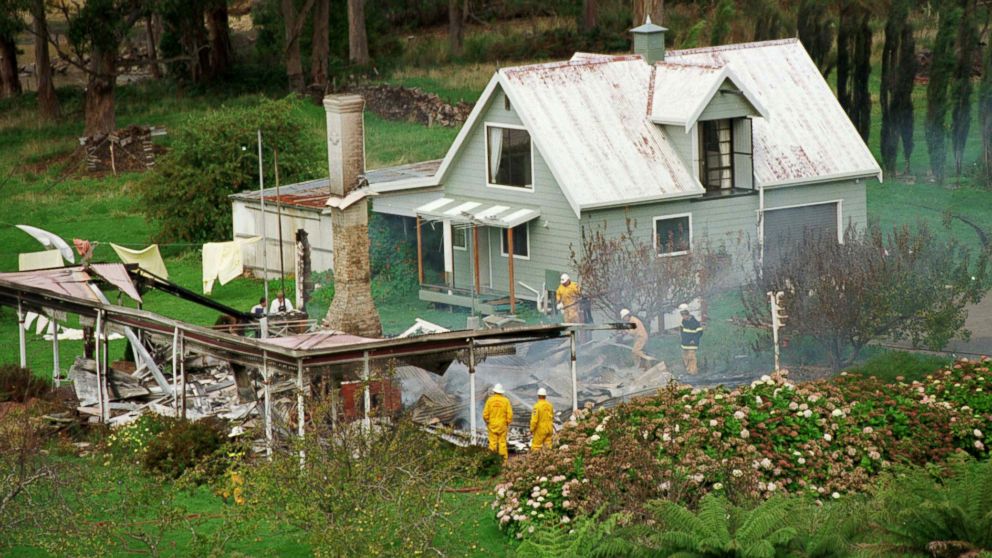
The government reacted immediately. Just twelve days after the shooting, Australia adopted the NFA, the National Firearms Agreement . This was precisely the agreement, because formally the issues of gun control were still in the jurisdiction of the states, and the document was an agreement between the center and local governments. He was unanimously supported by both major political parties in the country, Labor and Liberal. Документ провозглашал обязательную регистрацию оружия, ужесточал порядок выдачи лицензий (теперь, чтобы купить оружие, нужна была уважительная причина — и самооборона в число таких больше не входила) и совсем запрещал автоматические и полуавтоматические винтовки, а также помповые ружья. Соглашение включало программу выкупа у населения оружия, которое еще вчера считалось легальным, а после принятия закона оказалось запрещенным. Правительство опасалось массовых протестов, но австралийцы встретили Соглашение благосклонно и сдали более 640 тысяч единиц оружия в рамках программы выкупа.
Австралийцы встретили Национальное соглашение об огнестрельном оружии благосклонно и сдали более 640 тысяч единиц оружия
За довольно короткий срок страна полностью переосмыслила взгляд на владение оружием: из неотъемлемого права оно превратилось в привилегию, которую нужно было заслужить. Теперь любой, кто хочет претендовать на владение даже тем оружием, которое разрешено, должен получить лицензию . Данные о нем вносятся в национальный реестр, а процесс получения лицензии вовсе не формален: претендент должен пройти базовое обучение техники безопасности по аккредитованной государством программе, указать «уважительную причину» и подождать 28 дней — за это время биографические данные потенциального покупателя тщательно проверяются полицией .
В итоге массовые расстрелы в Австралии практически прекратились. Исключение — масс-шутинг 2018 года в городе Осмингтон , в результате которого погибли семь человек. По данным Гарвардского исследовательского центра по контролю травматизма (Harvard Injury Control Research Center), вдвое сократилось и число убийств и самоубийств с применением огнестрельного оружия — и, что важно, количество убийств и самоубийств другими способами при этом не увеличилось. Исследование 2017 года приводит даже более оптимистичные цифры: в результате NFA число смертей от огнестрельного оружия снизилось на 60%.
Рекордные прибыли оружейного лобби
Многие эксперты уверены, что США есть чему поучиться у Австралии. Но для этого нужен общественный консенсус, которого в Америке пока нет. Если в Австралии после масс-шутинга в Порт-Артуре политики и граждане единодушно решили, что оборот оружия нужно ограничить, то в США каждая попытка ограничить продажу оружия раскалывает общество на две части. Даже массовые расстрелы в США не слишком меняют расстановку сил в этой дискуссии.
Несмотря на статистику случаев насилия с применением огнестрельного оружия , около трети граждан США по-прежнему верят в то, что владение оружием сдерживает насилие. Эту идею активно поддерживают оружейное лобби, которое, разумеется, не заинтересовано в поиске компромиссов с другой стороной, а закон о лоббизме в США либеральнее, чем в большинстве развитых стран. На кону колоссальные деньги, и они растут. К примеру, у лидера рынка, оружейной компании Sturm Ruger & Co, рост прибыли в 2021 году составил 73%, а производства — 30%. Если в 2019 году годовая прибыль компании составила $410 млн, а в 2020 — $410 млн, то в 2021 — $730 млн. Растут и продажи оружия в целом: по данным Национальной системы мгновенной проверки криминального прошлого ФБР, в 2020 году количество заявок на покупку выросло на 20% по сравнению с 2019 годом.
Около трети граждан США по-прежнему верят в то, что владение оружием сдерживает насилие
В юридическом поле сторонники свободного оборота оружия тоже зачастую выигрывают: консервативные судьи охотно становятся на их сторону. Очень значимым в этом смысле оказалось дело «Округ Колумбия против Хеллера» (2008): тогда в дискуссию о том, трактовать ли Вторую поправку как индивидуальное или коллективное право, впервые с 1939 года вмешался Верховный суд. Судья Антонин Скалиа заявил , а большинство судей с ним согласились, что Вторая поправка гарантирует именно индивидуальное право на владение оружием — независимо от упомянутой в ее тексте службы в ополчении. В результате был отменен закон округа Колумбия от 1975 года, который значительно ограничивал покупку и хранение оружия.
Последняя крупная победа оружейного лобби состоялась 23 июля 2022 года, когда Верховный суд отменил принятые еще в 1911 году ограничения штата Нью-Йорк на скрытое ношение оружия вне дома. Постановление суда вновь трактовало Вторую поправку как право каждого человека «хранить и носить оружие» в индивидуальном порядке. Президент Джо Байден заявил , что глубоко разочарован этим решением:
«Это постановление противоречит как здравому смыслу, так и Конституции (…). После чудовищных атак в Буффало и Увальде, равно как и не попадающих в заголовки газет ежедневных актов насилия с применением огнестрельного оружия, мы как общество должны делать больше — а не меньше — для защиты наших соотечественников. (…) На кону — жизни».
С другой стороны, сторонники ужесточения контроля оборота оружия тоже не теряют времени, тем более что их активно поддерживает действующий президент. Уже на следующий день после упомянутого выше постановления Верховного суда Конгресс США отправил на подпись Джо Байдену законопроект, который называют «самым строгим федеральным законом, направленным на предотвращение насилия с использованием огнестрельного оружия, принятым за последние тридцать лет». Законопроект, принятый 234 голосами против 193 («за» проголосовали все демократы плюс 14 республиканцев), усиливает проверку биографических данных покупателей в возрасте до 21 года и предполагает выделение значительных средств для повышения безопасности школ. Кроме того, он закрывает печально известную «лазейку для бойфрендов» : ранее лицам, осужденным за домашнее насилие или находящимся под запретом о приближении (restraining order), было запрещено покупать оружие только в том случае, если они с жертвой находились в официальном браке или жили вместе. Теперь эта дыра в законодательстве закрыта.
По данным на 2021 год , ужесточение законов об оружии поддерживает чуть больше половины (52%) американцев; а 88% поддерживают идею сделать проверку биографических данных (backgound cheks) обязательной для всех штатов. Уровень поддержки традиционно коррелирует с политическими взглядами респондентов: если среди демократов за ужесточение выступает 91% опрошенных, то среди республиканцев — всего 24%. Двухпартийная система замедляет решение проблемы: хотя большинство американцев в целом за ужесточение контроля, для республиканцев (а их сегодня большинство в Палате представителей) важнее то, что среди их электората таких меньше половины, а щедрое финансирование от NRA служит дополнительной мотивацией ничего не менять.


